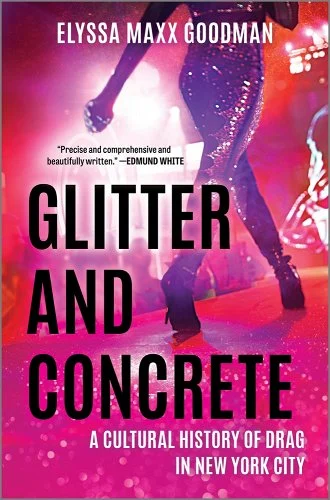[ad_1]
Glitter and Concrete: A Cultural History of Drag in New York City examines drag performance from the 19th Century through the contemporary era, from broad cultural trends to the individual experiences of performers. Elyssa Maxx Goodman dives into language, legalities, and the ebb and flow of perceptions.
I first met Goodman a year ago when she invited me to read at the Miss Manhattan Reading Series, a nonfiction series based in New York City that she’s been hosting for almost a decade. She works as a freelance photographer and writer. We caught up over Zoom in August to talk about her debut book.
This interview has been edited for clarity and length.

Ian MacAllen
How did you decide you wanted to write a book about drag performance?
Elyssa Maxx Goodman
Drag is beautiful. My introduction to drag actually comes from the point of view of costume design. When I was growing up, my mother would show me all these movie musicals from the 1950s, and they had all these beautiful twirling dresses in vibrant technicolor and I loved it. Around the time that I was seven years old, I saw To Wong Foo for the first time, and it was all the beautiful colors that I loved from these 1950s musical movies and the costumes were incredible, absolutely gorgeous. What I latched onto about it was that these were people who were happening now. This wasn’t from the 1950s, and that was really powerful for me as a kid. They had these fabulous outlooks that I latched onto and was inspired by, even as a child.
As I got older, I learned about the nature of what it means to live in a body. And the nature of the constraints of gender and the beauty of messing with them, and creating a version of yourself as a work of art. And it’s this beautiful act of not just hair and makeup and costume and glamor, but of rebellion and resistance, and taking up space in a world that tells you not to.
Ian MacAllen
One thing I found fascinating was how often there are changes to the perceptions of the ideal of drag. In the 1870s you talk about the male audience desire shifting to see women dressing as men in a more feminine way and to a more boyish way, and throughout the narrative there are these shifts that happen quickly. What was the catalyst for these kinds of changes?
Elyssa Maxx Goodman
I think a lot of what happened and continues to happen is that the relationships to drag changes when, in some way, men in power feel threatened. And it doesn’t necessarily mean they feel threatened by drag, necessarily. Drag sort of ends up bearing the brunt, and drag and marginalized identities overall end up bearing the brunt of their angst.
I noticed historically that this is when this happens, and in times of large cultural upheaval where men in power experience some kind of insecurity, they attack all people—people who they feel are beneath them. And historically drag has been among them.
Ian MacAllen
Prohibition changed things again, where drag spaces became shared speakeasy spaces—was there a sense of camaraderie, or was it that speakeasies were already illegal so it mattered less that people were bending morality laws at the time?
Elyssa Maxx Goodman
I wouldn’t say drag spaces became speakeasy spaces, but speakeasies developed a taste for the taboo. Because there was already a taboo based on the desire that everyone wanted to drink, and that brought people together in a way that they hadn’t been together before.
This was also a time when dating as we know it first began to take shape. Single men and single women were going out unchaperoned to a venue. There was just a lot that was happening socially, and it became a turning point. People were seeking out these spaces that were illegal and so doing things that were illegal became chic in their own way. There developed a taste for verboten.
Speakeasies became widely used and those spaces needed entertainment. One of the people I talk about in the book is Jean Malin, who started in drag and then became very famous for what became known as pansy performance. Pansy performance was a kind of heightened and unapologetic gay and flamboyant presence. And Jean’s popularity spawned a wave of pansy performers, and Jean would have performing alongside him different drag queens. That was the first time drag became associated with queerness as it is now. Before then it was kind of just a mode of performance.
In the late 19th century and early 20th century, there were a lot of women who did drag because if you wanted to do comedy, that was kind of what you had to do. There weren’t as many roles available for women doing comedy or in general, if you didn’t dress up.
The way that the roles—the way drag was viewed—changed with the pansy craze because it was, all of sudden, very closely associated with queerness by mainstream [straight] culture. Then you would have pansy and drag performances happening at the same places, and it was still a taste of the taboo. It was something that conservative public opinion would have railed against. There was very much a pushback against that sort of thinking in New York in the 1920s by a lot of artistic and society people. It was a rebellion against that sort of thinking, and it was about having a taste for the verboten and it expanded into a larger one.
Ian MacAllen
By the 1970s, the perceptions of queer and drag began to change once again—was it all just Bowie? Are there better reasons for that cultural shift?
Elyssa Maxx Goodman
What’s interesting about the 1970s was that a couple of things were happening. It was post-Stonewall, that queer liberation led to a sexual liberation, and in the 1970s you had a lot of the Clone aesthetic, a hyper masculine, a very butch look—work boots and flannel and thick mustaches and tight jeans where you would sand down the zipper so you could see the goods. It was a hyper masculine aesthetic that emerged after Stonewall, and a lot of those guys did not want to be seen around drag for the reasons of “that’s not me,” or “that’s not us.”
One of the ways that drag started to change was that it was not considered especially cool or hip during this time. That’s one part. Another part of it was this was a time now [when] many people who could only be themselves in underground situations didn’t have to be as underground anymore. It wasn’t always safe to be [someone] openly gender nonconforming who worked in the gender nonconformity space. This is another situation where phenomena don’t live in a vacuum, because obviously there was something happening in the culture where people found it safer to experiment with gender nonconformity than they had in the past and in a more public way.
The Bowie question is an interesting one because a lot of people take credit for that—one of them is Jayne County who is a transgender punk icon, but who is another person at the time who referred to herself as a drag queen. She began her transition after referring to herself as a drag queen. Also, Jackie Curtis who is a Warhol star, and their going on tour with Pork in England which David Bowie is coming to see—both Jackie and Jayne talk about, independently, how they came around before Bowie happened as Bowie.
David Bowie also acknowledged the work of Lindsay Kemp who was a theater and performance artist in England who lived in the gender nonconformity space. David Bowie actively acknowledged Lindsay Kemp as an influence. This is another case where phenomen[a] don’t live in a vacuum, because obviously there was something happening in the culture where people found it safe to experiment with gender nonconformity [more] than they had in the past and in a more public way.
Ian MacAllen
You mention in Bar’Do that there was an “anything goes atmosphere” that existed but you don’t think this could exist today because of camera phones and the way things exist online. How has digital culture changed drag culture today?
Elyssa Maxx Goodman
The dissemination is one way.
We were all able to see Meatball doing drag as George Santos because someone had filmed it and put it online. And I think another way it can affect the way you interact in a space, either consciously or unconsciously, is that there may be or may not be a consideration how this looks filmed. But the constant presence of a camera—it’s part of the way people interact with work.
There may be or may not be a consideration how this looks filmed. For some people that doesn’t matter, but for some it does. I’ve talked to people who have worked with drag artists for many years and one of the things they tell me is they don’t know if they would want to be one of these girls today, especially if they were a person who had been on Drag Race because there is so much limiting what you can do on stage, because you do want to be perceived in a certain way. No artist is a monolith—but the ever presence of a camera—it’s imprudent to say it’s part of the way people interact with work.
You have to be conscious that you are probably being filmed if you are on stage no matter who you are. Unless you have control over it like Patty LuPone does. I think it would be foolish to say it would never be part of a consideration.
Sometimes it’s just in the living—are you just out in the world or are you making sure that people know you are out in the world, and how does that affect the work that you make. That’s not unique to drag. That’s very much part of the social phenomenon of how we live now.
I was just writing about the relationship between drag and photography and how it’s changed over time and I think one of the things with social media, and maybe photography in general, is that there is a lot more control that performers have over their image than they used to have. Having good photos on social media if you’re a drag artist has become essential. It’s a way of documenting yourself and getting more gigs. It becomes a calling card. These girls have really nice studio portraits. Sharing images of yourself that are highly crafted have become a way of documenting yourself and the reverse can also be true, only sharing images where you are constructed a certain way—or it’s not as polished, and that’s also an act or choice.
The way that we choose to share images of ourselves and the kinds of images we share are all part of a larger story we’re trying to tell about ourselves and I think that’s absolutely true for drag. Drag is living in the social moment.

NONFICTION
Glitter and Concrete: A Cultural History of Drag in New York City
By Elyssa Maxx Goodman
Hanover Square Press
Published September 12, 2023

[ad_2]
Source link

